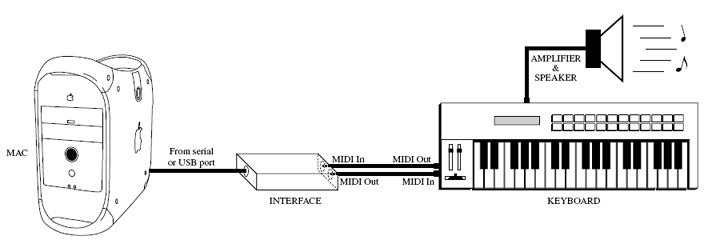|
L'aide française est disponible au format PDF en cliquant ici (ou dans le Menu "Démarrer", Finale 2010, Documentation PDF française)
Le tutoriel français est disponible au format PDF en cliquant ici.
La mise à jour de l'aide française au format HTML sera disponible prochainement.
|
Traduction française :

|
Setting up your MIDI system 

MIDI stands for Musical Instrument Digital Interface. It’s the language spoken by computers and electronic musical instruments. We’ll assume that you’re connecting a MIDI keyboard, although you can use any MIDI instrument. In this manual, “MIDI keyboard” refers to whatever type of MIDI device you are using.
At the very least, you’ll need the following equipment for an operational MIDI system (not including your computer):
A MIDI keyboard
Amplifier/speaker or headphones
Two MIDI cables
A MIDI interface with appropriate USB cable
The last item, a MIDI interface, is a box that translates the signals arriving from the MIDI keyboard into signals the computer understands, and vice versa. Interfaces can be very simple or very elaborate. The most basic ones require no external power and have ports (jacks) for a single MIDI keyboard; more expensive models have ports for multiple MIDI devices or other features. Most Macs have USB (Universal Serial Bus) ports, a standard that allows users to connect devices to their computers without needing to restart for the devices to become active.
- Place the computer, keyboard, and MIDI interface where you want them. Go ahead and plug in any power cords, but don’t turn anything on yet.
- Plug one end of the MIDI interface cable into the interface (if applicable). Plug the other end into the USB or serial port on the back of your Macintosh.
- Plug one end of a MIDI cable into the MIDI keyboard port marked MIDI In. Plug the other end into the MIDI interface port marked MIDI Out. Plug the second MIDI cable into the interface port marked MIDI In and the MIDI keyboard port marked MIDI Out. The most common problem encountered by a new MIDI user is improperly connected cables. The trick is to think of the route the music data is taking. The notes you play will leave your MIDI keyboard from the port marked Out, and enter the interface through the port marked In, then on to the computer. Similarly, when the computer plays back your music, the notes go out from the computer to the interface, leave the interface through the port marked Out, and enter your MIDI keyboard through the port marked In. So, although it may seem contrary to common sense, plug the In to the Out and vice versa.
Your connections should resemble those in this figure:

- Turn on all your equipment.
Your MIDI system is now configured. To name a MIDI device or configure additional settings, jump ahead to Configuring MIDI in OS X. If you do not wish to name a MIDI device or make additional settings, you can skip ahead to Starting Finale.
 Previous Previous
|
Next  |




